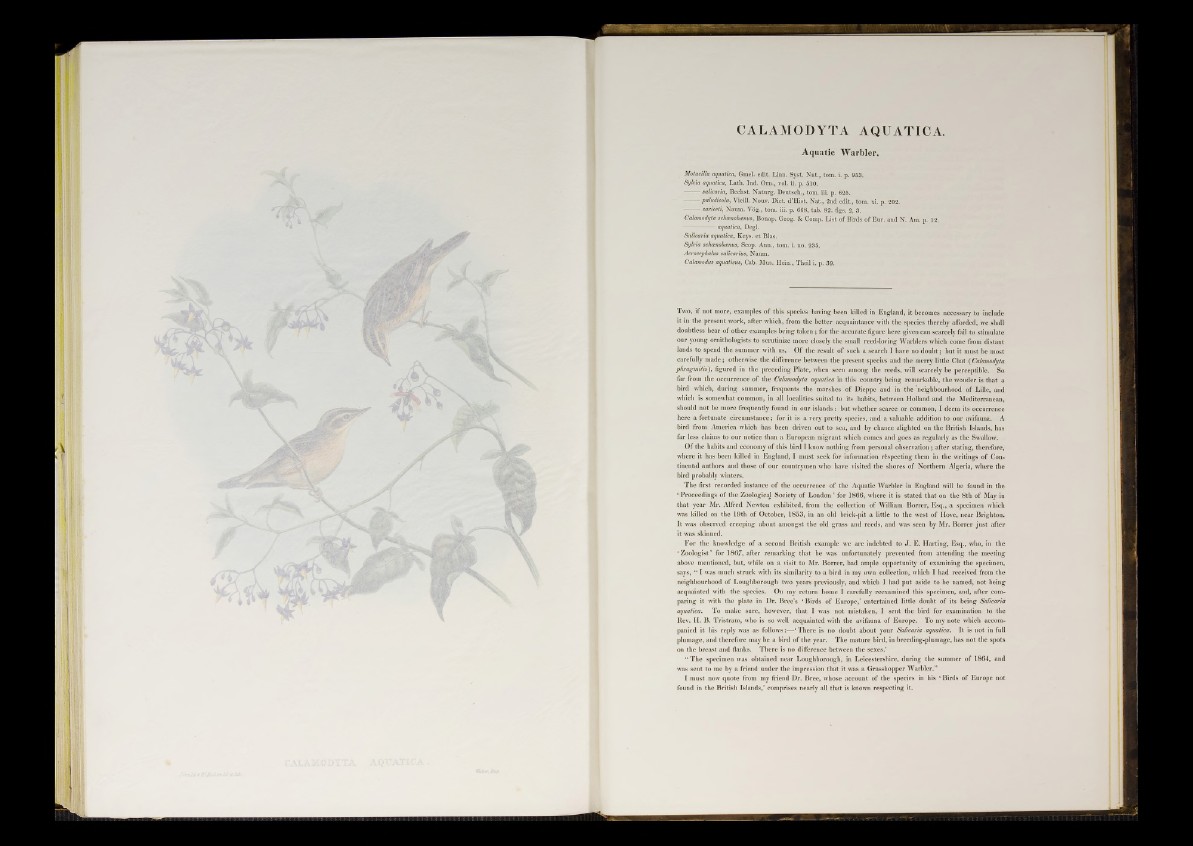
Aquatic Warbler,
Motacilla aquatica, Gmel. edit. Linn. Syst. Nat., tom. i. p. 953.
Sylvia aquatica, Lath. Ind. Orn., vol. ii. p. 510.
salicaria, Bechst. Naturg. Deutsch., tom. iii. p. 625.
paludicola, Vieill. Nouv. Diet. d’Hist. Nat., 2nd edit., tom. xi. p. 202.
cariceti, Naüm. Vög., tom. iii. p. 668, tab. 82. figs. 2, 3.
Calamodyta schcenobeenus, Bonap. Geog. & Comp. List of Birds of Eur. and N. Am. p. 12.
aquatica, Degl.
Salicaria aquatica, Keys, et Blas.
Sylvia schcenobeenus, Scop. Ann., torn. i. no. 235.
Acrocephalus salicarius, Naum.
Calamodus aquaticus, Cab. Mus. Hein., Theil i. p. 39.
Two, if not more, examples of this species haying been killed in England, it becomes necessary to include
it in the present work, after which, from the better acquaintance with the species thereby afforded, we shall
doubtless hear of other examples being taken ; for the accurate figure here given can scarcely fail to stimulate
our young ornithologists to scrutinize more closely the small reed-loving Warblers which come from distant
lands to spend the summer with us. Of the result of such a search I have no doubt; but it must be most
carefully made; otherwise the difference between the present species and the merry little Chat ( Calamodyta
phragmitis'), figured in the preceding Plate, when seen among the reeds, will scarcely be perceptible. So
far from the occurrence of the Calamodyta aquatica in this country being remarkable, the wonder is that a
bird which, during summer, frequents the marshes of Dieppe and in the neighbourhood of Lille, and
which is somewhat common, in all localities suited to its habits, between Holland and the Mediterranean,
should not be more frequently found in our islands: but whether scarce or common, I deem its occurrence
here a fortunate circumstance; for it is a very pretty species, and a valuable addition to our avifauna. A
bird from America which has been driven out to sea, and by chance alighted on the British Islands, has
far less claims to our notice than a European migrant which comes and goes as regularly as the Swallow.
Of the habits and economy of this bird I know nothing from personal observation; after stating, therefore,
where it has been killed in England, I must seek for information respecting them in the writings of Continental
authors and those of our countrymen who have visited the shores of Northern Algeria, where the
bird probably winters.
The first recorded instance of the occurrence of the Aquatic Warbler in England will be found in the
‘ Proceedings of the Zoological Society of London ’ for 1866, where it is stated that on the 8th of May in
that year Mr. Alfred Newton exhibited, from the collection of William Borrer, Esq., a specimen which
was killed on the 19th of October, 1853, in an old brick-pit a little to the west of Hove, near Brighton.
It was observed creeping about amongst the old grass and reeds, and was seen by Mr. Borrer just after
it was skinned.
For the knowledge of a second British example we are indebted to J . E. Harting, Esq., who, in the
‘ Zoologist’ for 1867, after remarking that he was unfortunately prevented from attending the meeting
above mentioned, but, while on a visit to Mr. Borrer, had ample opportunity of examining the specimen,
says, “ I was much struck with its similarity to a bird in my own collection, which I had received from the
neighbourhood of Loughborough two years previously, and which I had put aside to be named, not being
acquainted with the species. On my return home I carefully reexamined this specimen, and, after comparing
it with the plate in Dr. Bree’s ‘ Birds of Europe,’ entertained little doubt of its being Salicaria
aquatica. To make sure, however, that I was not mistaken, I sent the bird for examination to the
Rev. H. B. Tristram, who is so well acquainted with the avifauna of Europe. To my note which accompanied
it his reply was as follows:—‘ There is no doubt about your Salicaria aquatica. It is not in full
plumage, and therefore may be a bird of the year. The mature bird, in breeding-plumage, has not the spots
on the breast and flanks. There is no difference between the sexes.’
“ The specimen was obtained near Loughborough, in Leicestershire, during the summer of 1864, and
was sent to me by a friend under the impression that it was. a Grasshopper Warbler.”
I must now quote from my friend Dr. Bree, whose account of the species in his ‘ Birds of Europe not
found in the British Islands,’ comprises nearly all that is kilown respecting it.